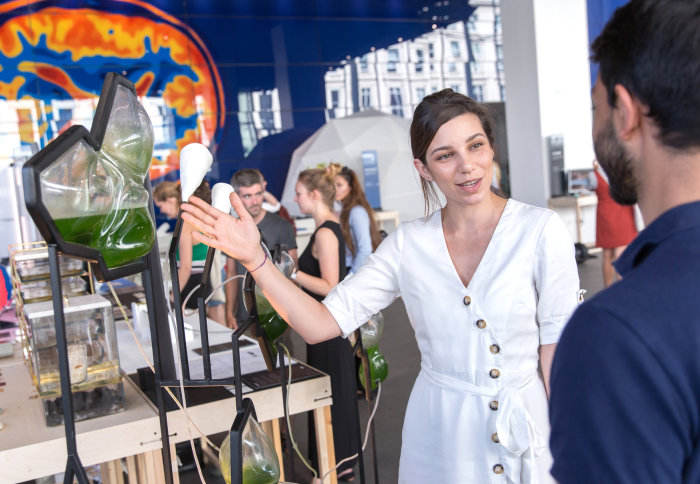Algae air purifiers and printable pixels: the students designing our future

Symbiont, developed by GID student Andriana Nassou
Students from the Dyson School of Design Engineering are offering a provocative insight into our future as they showcase their end of year projects.
The eye-opening exhibition, held this week at Imperial, features more than fifty examples of innovative design, revolutionary technology, and game-changing ideas from the School’s postgraduate students.
All students exhibiting their work are enrolled on either Innovation Design Engineering (IDE) or Global Innovation Design (GID) programmes – which are delivered jointly with the Royal College of Art.

Visitors to the exhibition can discover a bathroom mirror that acts as a personal wellbeing assistant, a grow-your-own alternative to plastic, and a football-sized observational bumblebee hive that could be attached to windows.
Many of the projects tackle real-world global problems such as those associated with sustainability, urban living, and healthcare. Jelly dots, created by Lewis Hornby, aims to address dehydration among dementia patients through super hydrating sweets. Syed Hussain Abid has developed an alternative fuel system for developing countries which uses readily available crop waste to make bioethanol and reduce reliance on foreign fuel imports. Hamza Oza has invented a wearable device that helps pilgrims to locate their lost family members during the Hajj, without relying on smartphones or mobile networks.

Other students look further ahead, imagining the technology future generations will need and want. Jun Kamei is developing a garment made from a porous and hydrophobic material which functions like a human ‘gill’, allowing us to breathe underwater. He envisages a future where rising sea levels may make this a part of daily life. Carolyn Tam has developed paintable pixels and wire that can turn any material or surface into a digital display. She imagines a screenless future, where digital data and internet content will be integrated seamlessly into every part of our built environment.
Hu-mind

Melisa Lenero Agraz, a GID student, has developed a technology called Hu-mind, which can detect the brain activity associated with unconscious bias and give the user feedback in real time about their decision-making.
A wearable device, inspired by the appearance of a pufferfish, would inflate when an unconscious bias is detected, acting as an alert to the wearer. She describes the technology as a new sense, one which can empower the user to understand more about themselves and the world around them, leading to more informed decision-making.
PhysicalReality

IDE student James Batsone’s PhysicalReality installation is an immersive experience that he says provides a new way to get people to question and understand the concept of risk.
Functioning like a ‘mechanical trust fall’, his contraption invites participants to experience the physical and emotional sensations of physical risk taking.
Interflex

IDE student Yikun Wang has invented a bra which alerts the wearer to poor posture.
Yikun says that the garment, which is called Interflex, can precisely measure upper body movement through flexible fabric sensors integrated into the material.
These sensors can detect if the wearer has been inactive or sitting incorrectly, and guide them to the correct posture with subtle vibrating pulses along the back and shoulders. She is also developing a tight-fitting t-shirt for men.
Symbiont
 Symbiont, developed by GID student Andriana Nassou, is a system which harnesses microalgae to purify the air of indoor spaces.
Symbiont, developed by GID student Andriana Nassou, is a system which harnesses microalgae to purify the air of indoor spaces.
The microalgae consume CO2, which is essential to their growth. As a by-product they release oxygen into the air for us to breathe.
Andriana explains that the system is based on the principle of symbiosis, which is a close, mutually beneficial interaction between two different organisms. She is envisioning a future where our everyday life is interconnected with micro-organisms through mutually beneficial relationships.
The exhibition will be open to the public from Wednesday 4 – Friday 6 July 2018 from 09:00 – 17:00 in the College’s Main Entrance.
Article text (excluding photos or graphics) © Imperial College London.
Photos and graphics subject to third party copyright used with permission or © Imperial College London.
Reporter
Deborah Evanson
Communications Division
Thomas Angus [Photographer]
Communications Division